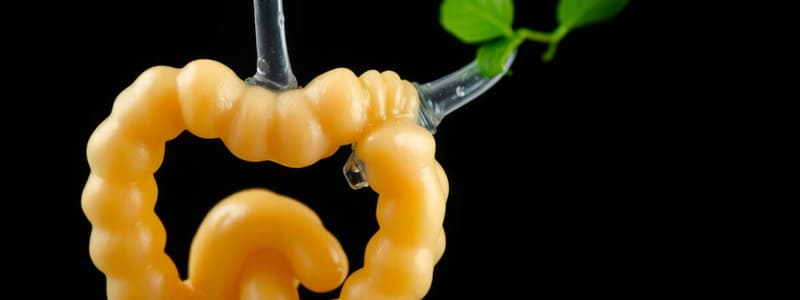Podcast
Questions and Answers
Where does carbohydrate digestion primarily begin?
Where does carbohydrate digestion primarily begin?
- In the small intestine
- In the esophagus
- In the mouth (correct)
- In the stomach
What is the main function of salivary a-amylase in carbohydrate digestion?
What is the main function of salivary a-amylase in carbohydrate digestion?
- To catalyze the hydrolysis of a-glycosidic linkages (correct)
- To convert disaccharides into monosaccharides
- To inactivate polysaccharides
- To absorb monosaccharides into the bloodstream
What is the primary site for carbohydrate digestion?
What is the primary site for carbohydrate digestion?
- Mouth
- Stomach
- Small intestine (correct)
- Large intestine
Which enzyme is responsible for breaking down maltose into glucose?
Which enzyme is responsible for breaking down maltose into glucose?
Which monosaccharide is produced from the hydrolysis of lactose?
Which monosaccharide is produced from the hydrolysis of lactose?
How are monosaccharides absorbed into the bloodstream from the intestinal wall?
How are monosaccharides absorbed into the bloodstream from the intestinal wall?
What happens to galactose and fructose after being absorbed in the bloodstream?
What happens to galactose and fructose after being absorbed in the bloodstream?
In what cellular location does glycolysis occur?
In what cellular location does glycolysis occur?
What is the main purpose of glycolysis?
What is the main purpose of glycolysis?
In the first stage of glycolysis, how many ATP molecules are consumed?
In the first stage of glycolysis, how many ATP molecules are consumed?
Which enzyme catalyzes the conversion of glucose 6-phosphate to fructose 6-phosphate?
Which enzyme catalyzes the conversion of glucose 6-phosphate to fructose 6-phosphate?
What molecule is generated as a product during the formation of 1,3-bisphosphoglycerate?
What molecule is generated as a product during the formation of 1,3-bisphosphoglycerate?
Which enzyme is involved in the formation of 2-phosphoglycerate from 3-phosphoglycerate?
Which enzyme is involved in the formation of 2-phosphoglycerate from 3-phosphoglycerate?
What are the resulting molecules after the cleavage of fructose 1,6-bisphosphate?
What are the resulting molecules after the cleavage of fructose 1,6-bisphosphate?
During glycolysis, which reaction is an ATP-producing step?
During glycolysis, which reaction is an ATP-producing step?
Which product is a result of the ATP hydrolysis during the phosphorylation steps of glycolysis?
Which product is a result of the ATP hydrolysis during the phosphorylation steps of glycolysis?
Flashcards are hidden until you start studying
Study Notes
Carbohydrate Digestion Process
- Digestion involves hydrolysis, breaking down food molecules into simpler chemical units for metabolic use.
- Carbohydrate digestion starts in the mouth, although it's minimal due to quick swallowing.
- Hydrolysis splits chemical bonds and incorporates water into resulting fragments.
- Salivary α-amylase, an enzyme in saliva, initiates the breakdown of starches into smaller polysaccharides and maltose.
- Stomach digestion of carbohydrates is limited; salivary α-amylase becomes inactive under acidic conditions, and no other enzymes are present.
Small Intestine and Enzymatic Breakdown
- The small intestine is the primary site for carbohydrate digestion.
- Pancreatic α-amylase continues the breakdown of polysaccharides into disaccharides like maltose.
- Disaccharidases, a group of glycoside hydrolases, convert disaccharides into monosaccharides:
- Maltase: maltose to glucose.
- Sucrase: sucrose to glucose and fructose.
- Lactase: lactose to glucose and galactose.
- The resulting monosaccharides (glucose, galactose, and fructose) are absorbed into the bloodstream through intestinal villi, rich in blood capillaries.
- Monosaccharide transport across cell membranes is facilitated by protein carriers.
- Galactose and fructose are converted to glucose metabolic products in the liver.
Glycolysis Overview
- Glycolysis, occurring in the cytosol, is the metabolic pathway converting glucose into two pyruvate molecules, producing energy (ATP and NADH).
- It involves two stages: the six-carbon stage and the three-carbon stage.
Six-Carbon Stage of Glycolysis
- Initial steps (1-3) involve converting ATP to ADP to transform monosaccharides into their phosphorylated forms.
- Step 1: Glucose 6-phosphate is formed via phosphorylation by hexokinase; energy from ATP hydrolysis is required.
- Step 2: Glucose 6-phosphate is isomerized to fructose 6-phosphate by phospho-gluco-isomerase.
- Step 3: Fructose 1,6-bisphosphate is formed through another phosphorylation reaction, facilitated by phospho-fructo-kinase.
Three-Carbon Stage of Glycolysis
- Steps (4-10) focus on the conversion of C6 biphosphate into two C3 monophosphate species.
- Step 4: Aldolase catalyzes the splitting of C6 biphosphate into dihydroxyacetone phosphate and glyceraldehyde 3-phosphate.
- Step 5: Dihydroxyacetone phosphate is isomerized to glyceraldehyde 3-phosphate by triose-phosphate isomerase.
- Step 6: Formation of 1,3-bisphosphoglycerate involves glyceraldehyde 3-phosphate dehydrogenase; NADH is produced and inorganic phosphate is used.
- Step 7: ATP production occurs as 1,3-diphosphoglycerate donates a phosphate to ADP, catalyzed by phospho-glycero-kinase.
- Step 8: 3-phosphoglycerate is isomerized to 2-phosphoglycerate, moving the phosphate group from carbon 3 to carbon 2, mediated by phospho-glycero-mutase.
- Step 9: Formation of phosphoenolpyruvate involves dehydration reactions leading to energy release for later ATP generation.
Studying That Suits You
Use AI to generate personalized quizzes and flashcards to suit your learning preferences.




